Contents
Sports Equipment Retail Business Plan
Keith’s Sporting Goods (KSG) sells athletic equipment to people of all fitness levels, from aspiring college athletes to weekend warriors. With our knowledgeable staff, we provide a comfortable environment for customers to seek training advice and discuss equipment needs.
Based in Eugene, KSG aims to become a recognized sporting goods store. We are actively searching for a high foot traffic location in central Eugene for easy access to our store.
We expect rapid growth due to our strong work ethic, desire, and enjoyment in our jobs. Sales are forecasted to increase by 2% each month, with a first-year growth rate of 12%. This assumption is supported by the 11.5% annual growth rate of the sporting goods wholesale industry.
Keith’s Sporting Goods will be filed as an S Corporation to provide liability protection and tax shields for owners. In the early stages, we will primarily use debt financing from a local bank and the Small Business Association (SBA), with the owner and operator investing the remaining funds.
We anticipate opening the store by January next year and generating strong profits by the end of the same year.
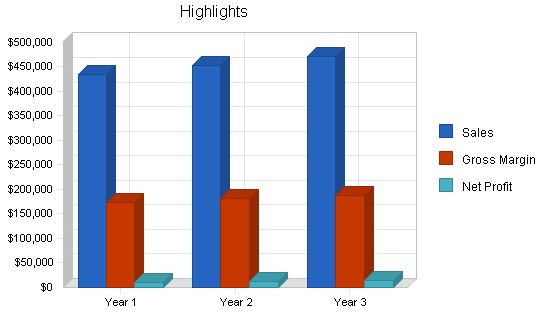
1.1 Objectives
The primary objectives for the store are:
- Brand recognition: KSG will be a recognized sporting goods and fitness store in Eugene.
- Profitability by the end of the first year of business.
- 15% growth rate in sales from years one and two, maintaining at least an 11.5% growth rate thereafter.
- Maintain a constant gross margin of 40% to allow for faster sales growth than total costs.
1.2 Mission
KSG strives to build long-term relationships with customers and employees. We work within the community, promote community service, and encourage additional education of our employees. Giving back to the community and providing opportunities for personal growth are important values for us.
Company Summary
KSG provides customers with quality products to maximize athletic performance and accomplish physical and mental goals. We have a knowledgeable staff who enjoys working in an athletic atmosphere and helping others. Located in Eugene, where there is a high concentration of health-conscious individuals and a devoted following to both high school and college athletics.
2.1 Company Ownership
I will own and operate Keith’s Sporting Goods, with a local investor who has an equal capital investment. The investor will receive dividends starting in year 2 until recouping the initial investment, with the option for the owner to buy out their shares. KSG will be filed as an S Corporation.
2.2 Start-up Summary
Keith’s Sporting Goods will be financed through 60% debt and 40% equity. A local bank will provide the debt, and the equity will come from an equal combination of owner investment and an angel investor. A significant portion of the initial investment will be spent on beginning inventory (83%), which is forecasted to sell within the first two months. Total assets will amount to 93.4% of the initial investment.
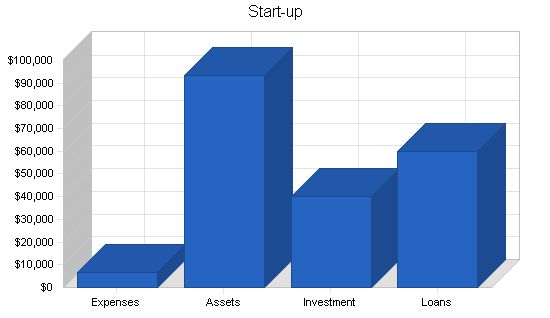
Start-up Requirements
Legal: $300
Operating Assets: $0
Brochures: $0
Consultants: $0
Insurance: $0
Rent: $4,310
Marketing/ Advertising – Grand Opening: $1,000
Renovation: $1,000
Other: $0
Total Start-up Expenses: $6,610
Start-up Assets
Cash Required: $8,489
Start-up Inventory: $82,901
Other Current Assets: $0
Long-term Assets: $2,000
Total Assets: $93,390
Total Requirements
$100,000
Start-up Funding
Start-up Expenses to Fund: $6,610
Start-up Assets to Fund: $93,390
Total Funding Required: $100,000
Assets:
Non-cash Assets from Start-up: $84,901
Cash Requirements from Start-up: $8,489
Additional Cash Raised: $0
Cash Balance on Starting Date: $8,489
Total Assets: $93,390
Liabilities and Capital
Liabilities:
Current Borrowing: $0
Long-term Liabilities: $60,000
Accounts Payable (Outstanding Bills): $0
Other Current Liabilities (interest-free): $0
Total Liabilities: $60,000
Capital:
Planned Investment:
Owner/Operator – $20,000
Angel Investor – $20,000
Additional Investment Requirement: $0
Total Planned Investment: $40,000
Loss at Start-up (Start-up Expenses): ($6,610)
Total Capital: $33,390
Total Capital and Liabilities: $93,390
Total Funding: $100,000
Products
Keith’s Sporting Goods will be a high-quality fitness store that focuses on athletic performance and maximization of athletic potential. In other words, KSG will supply athletes with essential products necessary for active lives.
The core products we will carry are: Shoes, Apparel, Athletic equipment.
To complement these goods, we will also carry training equipment like: Polymeric boxes, Medicine balls, Health supplements, Training literature.
Market Analysis Summary
The Eugene community is active and has a great athletic heritage. It is the location of the University of Oregon, home to many running and hiking trails, and has a youth athletic center called Kidsports. Eugene is a growing community that has always supported small entrepreneurs. KSG will focus on three main groups: Young parents with children active in youth sports, College students, Active adults. These groups comprise the majority of athletes in the city and have the disposable income to spend on athletic apparel.
4.1 Market Segmentation
Parents (Elementary & Middle School)
High School Athletes
College Students
Middle-aged Adults (35+)
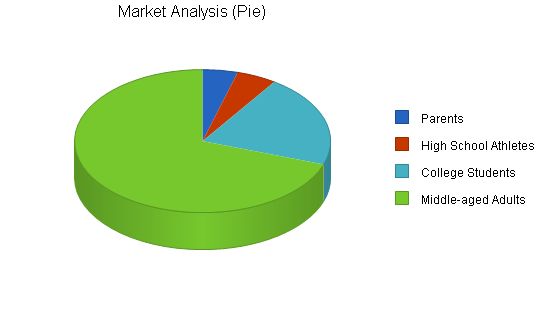
Market Analysis
Potential Customers Growth Year 1 Year 2 Year 3 Year 4 Year 5 CAGR
Parents 17% 3,150 3,686 4,313 5,046 5,904 17.01%
High School Athletes 25% 3,600 4,500 5,625 7,031 8,789 25.00%
College Students 7% 15,000 16,050 17,174 18,376 19,662 7.00%
Middle-aged Adults 10% 50,000 55,000 60,500 66,550 73,205 10.00%
Total 10.65% 71,750 79,236 87,612 97,003 107,560 10.65%
4.2 Target Market Segment Strategy
Because there are many different sports and levels at which to compete, there is a diverse range of markets for the company to target. At KSG, we will provide a marketplace that satisfies the needs of each group. We will stock a variety of goods for customers.
We strive to build long-term, personal relationships with our customers. To do this, we need to attract customers at young ages. Therefore, our primary target market will be parents with young children. By building a trust relationship, we may maintain a family through the child’s college years.
It is important to target these groups because youth sports have the highest growth rate in the athletic industry. Capturing the market at a young age will lead to future sales when athletes spend more on their athletic needs.
Young parents and high school students will not be the only groups we focus on because they are a smaller population. Focusing on college students and active adults will also be key.
4.3 Competition and Buying Patterns
To an athlete serious about achieving goals, having the correct athletic equipment is integral. Somebody who runs often needs shoes that not only last but also protect joints. It is the same for a basketball player who needs light clothing that allows movement. In either case, the athlete is looking for the best equipment and is open to try new, innovative products that might help reach peak performance.
In the sporting goods retailing, many companies compete in different ways. For example, Copeland’s sells products on a cost basis, sacrificing customer service and support.
As a smaller company, we intend to provide customers the support and knowledge they need to fulfill their goals.
Strategy and Implementation Summary
At KSG, we will use a marketing strategy of developing long-term relationships with our customers. Being seen at various sporting events will be integral to getting our name out in the community. We want to be seen as a business that cares for our customers and wants to see them accomplish their goals.
We want our customers to have complete trust in what our employees are saying. We want them to know all the information about what they are buying and what is best for them. If customers have good experiences with their purchases, they will be more likely to be repeat customers and will tell friends about the quality of operations at KSG.
5.1 Competitive Edge
The number one competitive edge KSG enjoys is providing customers with unparalleled service. As a smaller operation, it will be impossible to compete with Copeland’s and Play it Again sports on a price basis. Providing a group of knowledgeable employees who enjoy what they are doing is the only way that KSG can provide the best customer service. Once this trust is built, our competitive advantage can be sustained.
The type of equipment that KSG will provide will also be a source of competitive edge. Much of the equipment found at Keith’s will not be found at larger chain stores. KSG will provide quality equipment and will educate customers on why certain equipment is better than mainstream brand equipment.
5.2 Sales Strategy
Our sales strategy will be built around fully educating customers about their purchases. Many of the activities our store promotes impact the human body. It is important for the customer to be fully aware of the repercussions of the activity and how each piece of equipment affects them. Salespeople will take care of customers on a first-come, first-serve basis. We want to build customer relationships without discriminating against potential future customers.
Employees will be paid an hourly wage with no commissions at the beginning of operations. After the store has a history, a commission package based on sales and education advancement can be implemented.
KSG will carry a relatively low amount of inventory and have frequent order repurchases to maintain inventory levels and storage costs. Finally, all sales will be in cash to prevent problems brought along by late accounts receivable payments.
5.2.1 Sales Forecast
The primary products at KSG will include athletic shoes and apparel. We will also sell equipment, supplements, and health literature, but we forecast shoes and apparel to drive sales. We expect strong growth in the first year due to intense marketing and exposure in the Eugene market. Forecasted sales are expected to increase by 2% from month to month in the first year and then grow at the industry average of 11.50% per year.
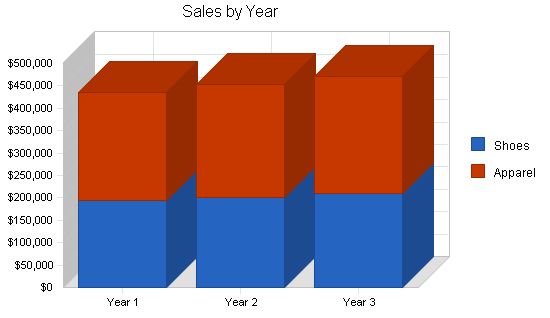
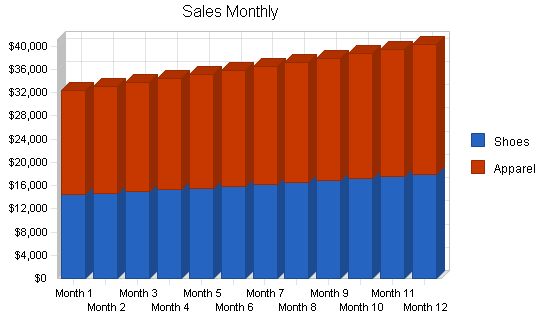
Sales Forecast:
| Sales Forecast | |||
| Year 1 | Year 2 | Year 3 | |
| Sales | |||
| Shoes | $193,134 | $201,245 | $209,697 |
| Apparel | $241,418 | $251,557 | $261,619 |
| Total Sales | $434,552 | $452,802 | $471,316 |
Management Summary:
The owner of KSG will also be the operator and decision maker. The philosophy behind the workforce will be total customer satisfaction and education. Since many customers are not aware of the repercussions brought on by athletics, employees will be encouraged to gain new knowledge and insight.
Personnel Plan:
Keith’s Sporting Goods will begin operations with a small work crew with the intention to grow as the business grows. The owner/operator will have a base salary of $3,000/mo, which will be a fixed expense.
We plan on starting with one full-time store manager who will work closely with the owner. During slow hours, they will work on implementing new strategies and making store changes. The manager will work 40 hours per week and have weekends off. The manager’s salary, below, includes benefits (paid sick time, holidays, and insurance coverage).
The owner will work the weekends with the other employees. Aside from the owner and manager, KSG will need an estimated 51 man-hours over the course of the week. Employees will make $8/hr and will be an integral part of the operation.
| Personnel Plan | |||
| Year 1 | Year 2 | Year 3 | |
| Owner Operator | $36,000 | $36,000 | $40,000 |
| Manager | $43,200 | $45,000 | $46,000 |
| Employees | $22,032 | $24,000 | $25,000 |
| Total People | 5 | 6 | 6 |
| Total Payroll | $101,232 | $105,000 | $111,000 |
Keith’s Sporting Goods will regularly monitor all financial statements because they have a direct correlation with the health of our business. We have forecasted a steady but moderate growth rate of 2% each month. All sales will be in cash, leading to positive cash flows whenever asset acquisition is maintained. Profits will be reinvested into the business for future product and store expansions. Excess cash will be invested in the market through a respected financial consultant if no appropriate investment opportunities arise.
Important Assumptions:
- Growth rate of 2% per month
- Daily sales: six pairs of shoes per day at $80 each, and 24 apparel items per day at $25 each
- Growth will be steady throughout the year
General Assumptions:
| General Assumptions | |||
| Year 1 | Year 2 | Year 3 | |
| Plan Month | 1 | 2 | 3 |
| Current Interest Rate | 10.00% | 10.00% | 10.00% |
| Long-term Interest Rate | 10.00% | 10.00% | 10.00% |
| Tax Rate | 25.42% | 25.00% | 25.42% |
| Other | 0 | 0 | 0 |
The following table and chart show our break-even point.
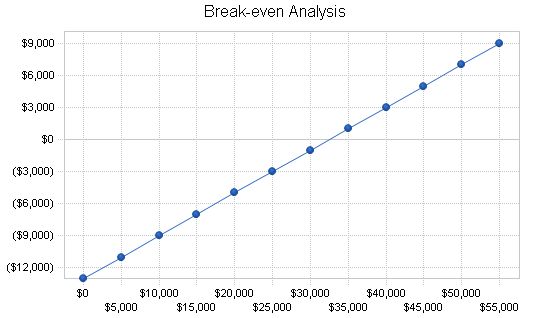
Break-even Analysis
Monthly Revenue Break-even: $32,540
Assumptions:
– Average Percent Variable Cost: 60%
– Estimated Monthly Fixed Cost: $13,016
Projected Profit and Loss
Due to low overhead, we expect early profits in our business. Depending on the accuracy of our forecasts, we will adjust marketing and other long-term assets to add value.
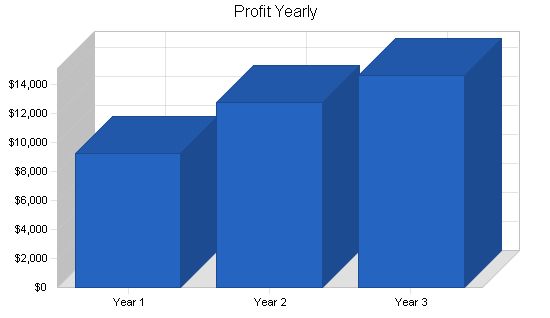
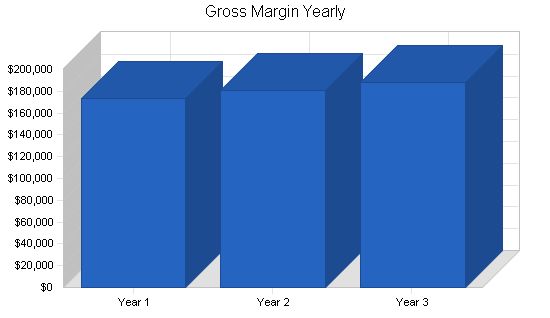
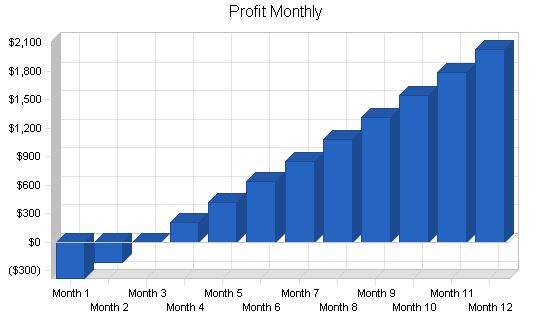
Pro Forma Profit and Loss
Sales:
Year 1 – $434,552
Year 2 – $452,802
Year 3 – $471,316
Direct Cost of Sales:
Year 1 – $260,731
Year 2 – $271,681
Year 3 – $282,790
Other:
Year 1 – $0
Year 2 – $0
Year 3 – $0
Total Cost of Sales:
Year 1 – $260,731
Year 2 – $271,681
Year 3 – $282,790
Gross Margin:
Year 1 – $173,821
Year 2 – $181,121
Year 3 – $188,526
Gross Margin %:
Year 1 – 40.00%
Year 2 – 40.00%
Year 3 – 40.00%
Expenses:
Payroll:
Year 1 – $101,232
Year 2 – $105,000
Year 3 – $111,000
Sales and Marketing and Other Expenses:
Year 1 – $21,600
Year 2 – $21,600
Year 3 – $21,600
Depreciation:
Year 1 – $0
Year 2 – $0
Year 3 – $0
Utilities:
Year 1 – $9,600
Year 2 – $9,600
Year 3 – $9,600
Rent:
Year 1 – $23,760
Year 2 – $23,760
Year 3 – $23,760
Payroll Taxes:
Year 1 – $0
Year 2 – $0
Year 3 – $0
Other:
Year 1 – $0
Year 2 – $0
Year 3 – $0
Total Operating Expenses:
Year 1 – $156,192
Year 2 – $159,960
Year 3 – $165,960
Profit Before Interest and Taxes:
Year 1 – $17,629
Year 2 – $21,161
Year 3 – $22,566
EBITDA:
Year 1 – $17,629
Year 2 – $21,161
Year 3 – $22,566
Interest Expense:
Year 1 – $5,350
Year 2 – $4,200
Year 3 – $3,000
Taxes Incurred:
Year 1 – $3,042
Year 2 – $4,240
Year 3 – $4,973
Net Profit:
Year 1 – $9,236
Year 2 – $12,721
Year 3 – $14,593
Net Profit/Sales:
Year 1 – 2.13%
Year 2 – 2.81%
Year 3 – 3.10%
7.4 Projected Cash Flow
As a retailer, we do not sell on credit, but all inventory purchases are made on account. Our net cash outflows are largely a result of repaying the initial loan.
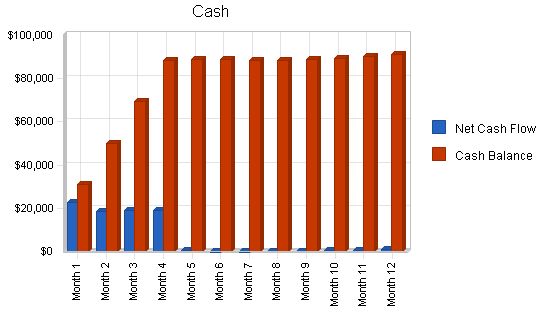
Pro Forma Cash Flow
| Pro Forma Cash Flow | |||
| Year 1 | Year 2 | Year 3 | |
| Cash Sales | $434,552 | $452,802 | $471,316 |
| Subtotal Cash from Operations | $434,552 | $452,802 | $471,316 |
| Sales Tax, VAT, HST/GST Received | $0 | $0 | $0 |
| New Long-term Liabilities | $0 | $0 | $0 |
| Principal Repayment of Current Borrowing | $0 | $0 | $0 |
| Long-term Liabilities Principal Repayment | $12,000 | $12,000 | $12,000 |
| Subtotal Cash Spent | $351,667 | $464,901 | $478,980 |
| Net Cash Flow | $82,885 | ($12,099) | ($7,664) |
| Cash Balance | $91,374 | $79,275 | $71,611 |
7.5 Projected Balance Sheet
Monitoring liabilities and assets, cash is of particular importance to our organization. We will constantly monitor this section of the Balance Sheet. Without cash, we will be unable to react to market changes or survive tough economic cycles. Our net worth will improve as we grow and pay off the initial loan.
| Pro Forma Balance Sheet | |||
| Year 1 | Year 2 | Year 3 | |
| Cash | $91,374 | $79,275 | $71,611 |
| Inventory | $26,588 | $27,705 | $28,838 |
| Other Current Assets | $0 | $0 | $0 |
| Total Current Assets | $117,962 | $106,980 | $100,449 |
| Long-term Assets | $2,000 | $2,000 | $2,000 |
| Total Long-term Assets | $2,000 | $2,000 | $2,000 |
| Total Assets | $119,962 | $108,980 | $102,449 |
| Current Liabilities | $29,335 | $27,633 | $28,509 |
| Long-term Liabilities | $48,000 | $36,000 | $24,000 |
| Total Liabilities | $77,335 | $63,633 | $52,509 |
| Paid-in Capital | $40,000 | $40,000 | $40,000 |
| Retained Earnings | ($6,610) | ($7,374) | ($4,653) |
| Earnings | $9,236 | $12,721 | $14,593 |
| Total Capital | $42,626 | $45,347 | $49,940 |
| Total Liabilities and Capital | $119,962 | $108,980 | $102,449 |
| Net Worth | $42,626 | $45,347 | $49,940 |
7.6 Business Ratios
The table below contains important business ratios from the sporting goods shops industry (5491), as determined by the Standard Industry Classification (SIC) Index.
| Ratio Analysis | ||||
| Sales Growth | 0.00% | 4.20% | 4.09% | 4.20% |
| Percent of Total Assets | ||||
| Inventory | 22.16% | 25.42% | 28.15% | 40.20% |
| Other Current Assets | 0.00% | 0.00% | 0.00% | 24.30% |
| Total Current Assets | 98.33% | 98.16% | 98.05% | 81.10% |
| Long-term Assets | 1.67% | 1.84% | 1.95% | 18.90% |
| Total Assets | 100.00% | 100.00% | 100.00% | 100.00% |
| Current Liabilities | 24.45% | 25.36% | 27.83% | 44.70% |
| Long-term Liabilities | 40.01% | 33.03% | 23.43% | 13.00% |
| Total Liabilities | 64.47% | 58.39% | 51.25% | 57.70% |
| Net Worth | 35.53% | 41.61% | 48.75% | 42.30% |
| Percent of Sales | ||||
| Sales | 100.00% | 100.00% | 100.00% | 100.00% |
| Gross Margin | 40.00% | 40.00% | 40.00% | 31.80% |
| Selling, General & Administrative Expenses | 33.60% | 22.50% | 21.21% | 19.00% |
| Advertising Expenses | 1.66% | 0.85% | 0.77% | 1.90% |
| Profit Before Interest and Taxes | 4.06% | 4.67% | 4.79% | 1.40% |
| Main Ratios | ||||
| Current | 4.02 | 3.87 | 3.52 | 1.97 |
| Quick | 3.11 | 2.87 | 2.51 | 0.75 |
| Total Debt to Total Assets | 64.47% | 58.39% | 51.25% | 57.70% |
| Pre-tax Return on Net Worth | 28.81% | 37.40% | 39.18% | 3.40% |
| Pre-tax Return on Assets | 10.24% | 15.56% | 19.10% | 8.20% |
| Additional Ratios | Year 1 | Year 2 | Year 3 | |
| Net Profit Margin | 2.13% | 2.81% | 3.10% | n.a |
| Return on Equity | 21.67% | 28.05% | 29.22% | n.a |
| Activity Ratios | ||||
| Inventory Turnover | 8.89 | 10.01 | 10.00 | n.a |
| Accounts Payable Turnover | 9.13 | 12.17 | 12.17 | n.a |
| Payment Days | 27 | 31 | 30 | n.a |
| Total Asset Turnover | 3.62 | 4.15 | 4.60 | n.a |
| Debt Ratios | ||||
| Debt to Net Worth | 1.81 | 1.40 | 1.05 | n.a |
| Current Liab. to Liab. | 0.38 | 0.43 | 0.54 | n.a |
| Liquidity Ratios | ||||
| Net Working Capital | $88,626 | $79,347 | $71,940 | n.a |
| Interest Coverage | 3.30 | 5.04 | 7.52 | n.a |
| Additional Ratios | ||||
| Assets to Sales | 0.28 | 0.24 | 0.22 | n.a |
| Current Debt/Total Assets | 24% | 25% | 28% | n.a |
| Acid Test | 3.11 | 2.87 | 2.51 | n.a |
| Sales/Net Worth | 10.19 | 9.99 | 9.44 | n.a |
| Dividend Payout | 0.00 | 0.79 | 0.69 | n.a |
Appendix
Sales Forecast
